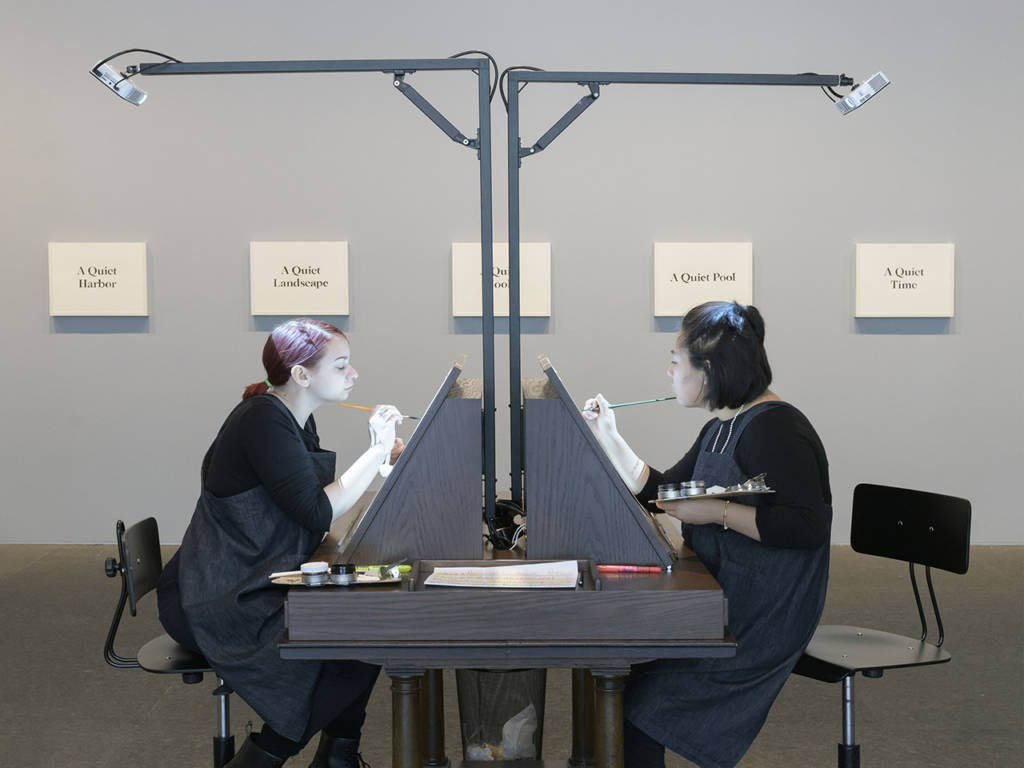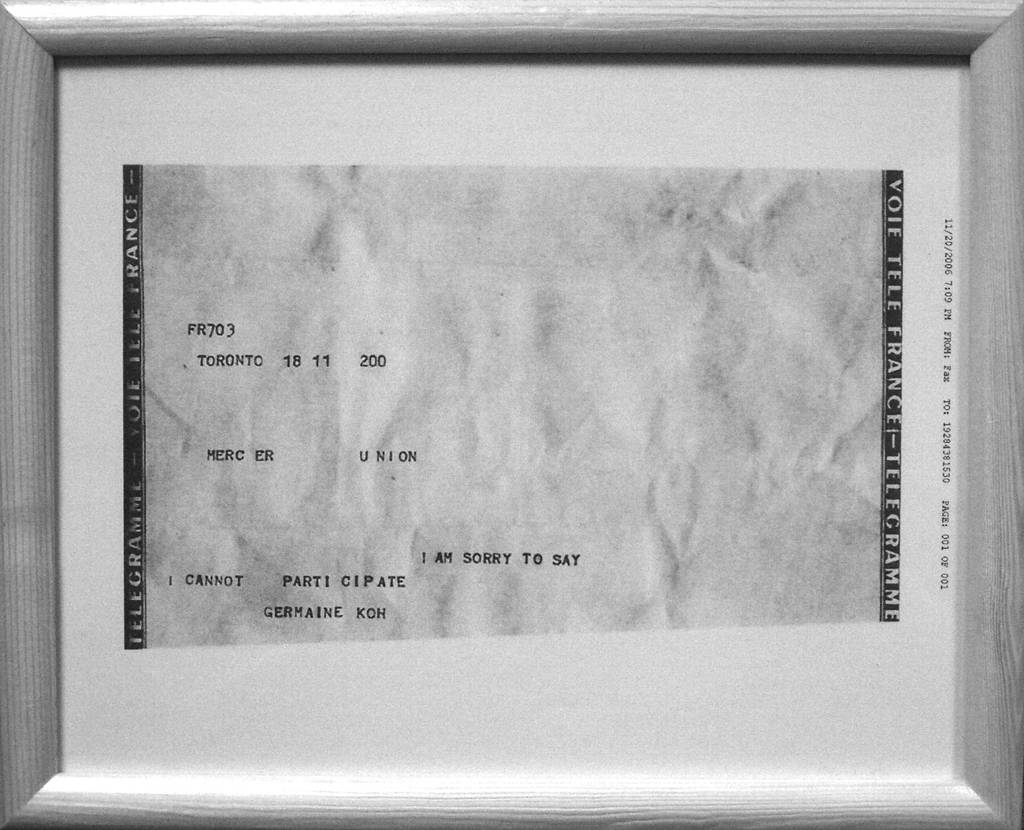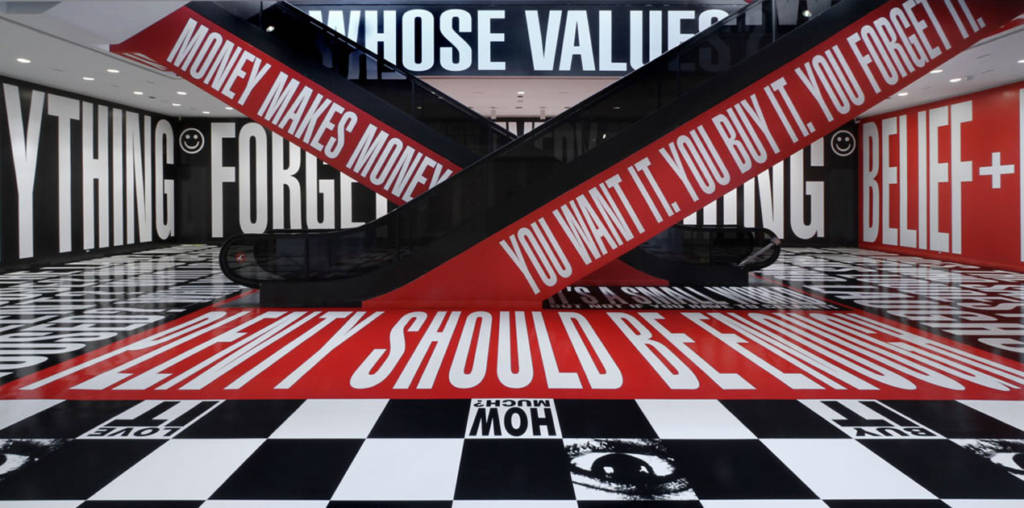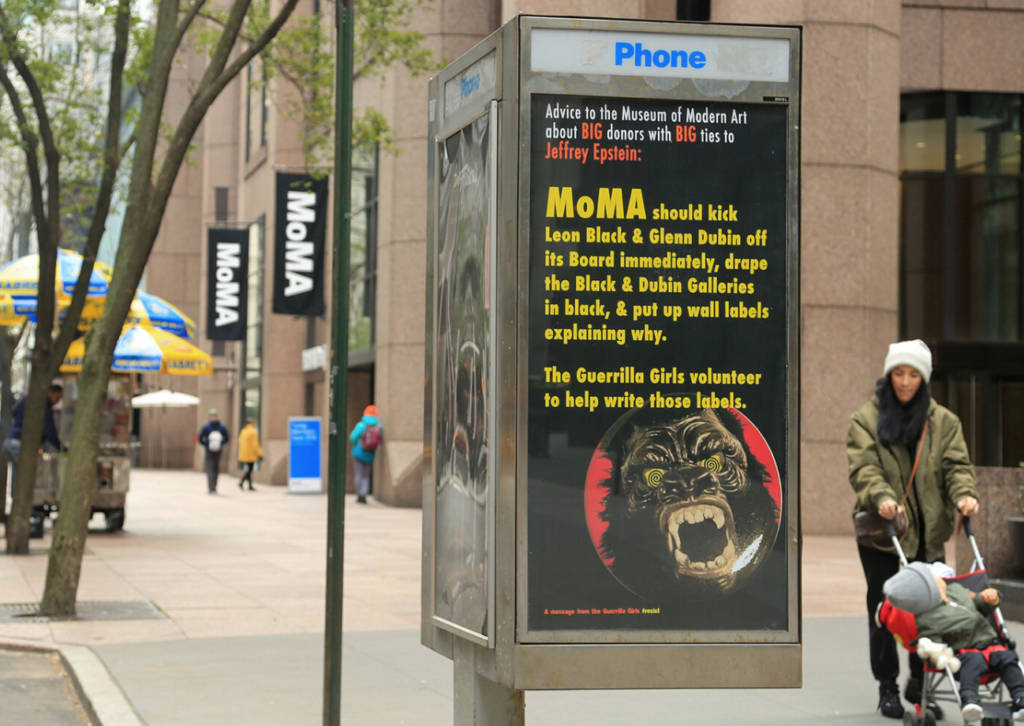SUMMARY OF WORK IN WEEK 2: (See details below)
- LOOK AT: Text as Art images, text and videos
2. WRITE: See reflection questions on text as art at the end.
- LOOK AT: Artists who use text in their work including: Yoko Ono, Jenny Holzer, John Baldessari, Barbara Krueger, Geurilla Girls, and Shelly Niro. And more contemporary examples including: Nadia Myre, Joi T. Arcand, Jon Rubin, Eleanor King, Micah Lexier, Lenka Clayton, Alisha Wormsley and Germaine Koh.
John Baldessari:

I Will Not Make Any More Boring Art
1971
In 1971, the Nova Scotia College of Art and Design, Halifax, invited John Baldessari to exhibit his work. However, the college did not have the funds for Baldessari to travel to Halifax, so the artist proposed that the art students in Halifax act as his surrogates. The students were instructed by Baldessari to write “I will not make any more boring art” on the gallery walls for the duration of the exhibition (April 1-10, 1971). By enlisting the art students to slavishly write the phrase over and over, Baldessari poked fun at the entire system of art education, which he felt encouraged students to imitate rather than experiment and innovate. The artist also sent along a handwritten page of the phrase, from which the students produced prints. After the work’s completion, Baldessari committed his own version of the piece to videotape. The subversive, graffiti-like action of drawing directly on the gallery walls reflected the artist’s dissatisfaction with the limitations of traditional painting in the early 1970s. His interest in language-based performative actions that could be realized by others was a hallmark of early conceptual art. (From Whitney.org)


John Baldessari, Tips for Artists Who Want to Sell, 1966-1968

By 1966, Baldessari was using photographs and text, or simply text, on canvas.[2] His early major works were canvas paintings that were empty but for painted statements derived from contemporary art theory. An early attempt of Baldessari’s included the hand-painted phrase “Suppose it is true after all? WHAT THEN?” (1967) on a heavily worked painted surface. However, this proved personally disappointing because the form and method conflicted with the objective use of language that he preferred to employ. Baldessari decided the solution was to remove his own hand from the construction of the image and to employ a commercial, lifeless style so that the text would impact the viewer without distractions. The words were then physically lettered by sign painters, in an unornamented black font. The first of this series presented the ironic statement “A TWO-DIMENSIONAL SURFACE WITHOUT ANY ARTICULATION IS A DEAD EXPERIENCE” (1967).”
text: https://en.wikipedia.org/wiki/John_Baldessari
image: https://imageobjecttext.com/tag/john-baldessari/
Lenka Clayton, Fruit and Other Things, 2018

Collaboration with Jon Rubin / Carnegie International 57th Edition 2018, Carnegie Museum of Pittsburgh
Full Project Website
“From 1896 to 1931 the Carnegie International selected artworks for its exhibitions from an international competition. The museum kept meticulous records, not only of all the works accepted, but of those rejected as well. Only the title, artist’s names, and the year of each work were recorded, no images exist. Over this 35 year span, 10,632 artworks were rejected from the exhibitions. For the duration of the 57th Carnegie International, each of the 10,632 rejected titles were made into individual hand-lettered text paintings. Each text painting was exhibited for a day, and then given away to visitors.”
Text and image: https://www.fruitandotherthings.com/home
Germaine Koh, Dear Mercer, 2006

unlimited series”
text and image: http://germainekoh.com/ma/projects_detail.cfm?pg=projects&projectID=19
YOKO ONO, Grapefruit, 1964

“Ono’s event scores were intended to replace a physical work of art with written instructions or suggestions for acts that the person experiencing them could create. Pulse Piece, for example, suggests, “Listen to each other’s pulse by putting your ear on the other’s stomach. 1963 Winter.” The activities usually highlight a simple day-to-day activity. Often considered a Fluxus work, Grapefruit has become a monument of conceptual art. The title comes from the way Ono felt about herself: a hybrid between American and Japanese identities, the way a grapefruit is a hybrid between a lemon and an orange.”
Text and Image:
https://www.swanngalleries.com/news/art-press-illustrated-books/2017/06/grapefruit-yoko-ono-guide-living-art/





Jenny Holzer, Truisms, 1980-


Holzer’s Truisms have become part of the public domain, displayed in storefronts, on outdoor walls and billboards, and in digital displays in museums, galleries, and other public places, such as Times Square in New York. Multitudes of people have seen them, read them, laughed at them, and been provoked by them. That is precisely the artist’s goal.
The Photostat, Truisms, seen here presents eighty-six of Holzer’s ongoing series of maxims. Variously insightful, aggressive, or comic, they express multiple viewpoints that the artist hopes will arouse a wide range of responses. A small selection of Truisms includes: “A lot of professionals are crackpots”; “Abuse of power comes as no surprise”; “Bad intentions can yield good results”; and “Categorizing fear is calming.”
Holzer began creating these works in 1977, when she was a student in an independent study program. She hand-typed numerous “one liners,” or Truisms, which she has likened, partly in jest, to a “Jenny Holzer’s Reader’s Digest version of Western and Eastern thought.” She typeset the sentences in alphabetical order and printed them inexpensively, using commercial printing processes. She then distributed the sheets at random and pasted them up as posters around the city. Her Truisms eventually adorned a variety of formats, including T-shirts and baseball caps. (From MOMA.org)
Jenny Holzer, Survival Series, 1986

In the Survival Series, Holzer explores other methods of presentation. Survival Series (1983–1985), which warned about the dangers of everyday living, were blazoned on enormous electronic signboards in public spaces.
From https://walkerart.org/collections/artists/jenny-holzer
Barbara Kruger, Untitled (Your body is a battleground), 1989

Kruger has said that “I work with pictures and words because they have the ability to determine who we are and who we aren’t.”[15] A larger category that threads through her work is the appropriation and alteration of existing images. In describing her use of appropriation, Kruger states:
Pictures and words seem to become the rallying points for certain assumptions. There are assumptions of truth and falsity and I guess the narratives of falsity are called fictions. I replicate certain words and watch them stray from or coincide with the notions of fact and fiction.[16]”
Image and Text: https://en.wikipedia.org/wiki/Barbara_Kruger#/media/File:Untitled_(Your_body_is_a_battleground).jpg

Image: https://www.widewalls.ch/consumerist-culture-art-10-artworks/
BARBARA KRUGER: BELIEF+DOUBT 2012–ONGOING

At a moment when ideological certitude and purity seem especially valued, Kruger says she’s “interested in introducing doubt.” Large areas of the installation are devoted to open-ended questions (“WHO IS BEYOND THE LAW? WHO IS FREE TO CHOOSE? WHO SPEAKS? WHO IS SILENT?”), while the section occupying the bookstore explores themes of desire and consumption. At once addressing the individual, the museum, and, symbolically, the country, Kruger’s penetrating examination of the public sphere transforms one of the Hirshhorn’s key public spaces.
Text + Image: https://hirshhorn.si.edu/exhibitions/barbara-kruger-beliefdoubt/
Guerrilla Girls, Guerrilla Girls Definition Of A Hypocrite, 1990

appear. The answer to their provocation? The state accused both men of murdering women (Simpson: his ex-wife Nicole Brown Simpson; Andre: his wife Ana Mendieta). Both enjoyed acquittals and avoided jail time. The Guerilla Girls discuss the prevalence of domestic violence beneath the pictures. They also include a tagline at the bottom: “A public service message from Guerilla Girls conscience of the art world.”
Another famous work, Do Women Have to Be Naked to Get Into the Met Museum? (1989), critiques the lack of art by female practitioners in major institutions. Across the Guerilla Girls’s oeuvre, wry ideology becomes an art form. Their messaging—and its situation within the institutions it critiques—supersedes all other aesthetic concerns.”
Image and Text: https://www.artsy.net/article/artsy-editorial-13-artists-highlight-power

https://www.guerrillagirls.com/

Roberts identifies dozens of Black names that Microsoft Word identifies as misspelled. Series of prints.
Shelley Niro, The Shirt (detail), 2003

“In “The Shirt” – a video that debuted at the 2003 Venice Biennale – Kanien’kehaka (Mohawk) artist and director Shelley Niro parodies the archetypal tourist tee-shirt from the point of view of First Nations Peoples as an exploration into the lasting effects of European colonialism in North America. Facing the camera directly and poised against the landscape of “America”, an Aboriginal woman with biker-like accessories bears a sequential series of statements on her tee-shirt that together comprise a discourse on colonialism. The darkly ironic and yet brutally truthful messages of “The Shirt” draw attention to the history of invasion that indigenous peoples have experienced in North America. By presenting the tee-shirts as souvenirs and memories of these impositions, Niro’s work suggests that the consequences of colonialism are still active today. The Shirt is an ironic and humorous take on colonialism enacted through text on T-shirts worn by an Aboriginal woman (artist Hulleah Tsinhnahjinnie). Directly facing the camera with the landscape of “America” as a backdrop, the woman poses in shirts that bear a sequential series of statements that together comprise a discourse on North America’s troubled past.”
Text:https://www.gallery.ca/collection/artwork/the-shirt
Image: https://www.thestar.com/entertainment/visualarts/2017/05/21/shelley-niro-the-way-of-the-subtle-warrior.html
Joi T. Arcand, Northern Pawn, South Vietnam, 2009

Here on Future Earth is a series of photographs that Arcand produced in 2010. In a phone interview, Arcand explained to me that this is where her photo-based practice and her interest in textuality synched. Arcand wants us to think about these photographs as documents of “an alternative present,” of a future that is within arm’s reach.
For this series, Arcand manipulated signs and replaced their slogans and names with Cree syllabics. By doing this, Arcand images something of a present beside itself and therefore loops us into a new mode of perception, one that enables us to attune to the rogue possibilities bubbling up in the thick ordinariness of everyday life. Arcand wanted to see things “where they weren’t.”
Hers is not a utopian elsewhere we need to map out via an ethos of discovery. Rather, Arcand straddles the threshold of radical hope. She asks us to orient ourselves to the world as if we were out to document or to think back on a future past. That is, Arcand rendered these photographs with a pink hue and a thick, round border, tapping into what she calls “the signifiers of nostalgia.” Importantly, these signifiers are inextricably bound to the charisma of words, to the emotional life of the syllabics. The syllabics are what enunciate; they potentiate a performance of world-making that does not belong to the mise-en-scene of settlement.”
Text and Image: https://canadianart.ca/features/optics-language-joi-t-arcand-looks-words/
Joi T. Arcand, Amber Motors, 2009

Nadia Myre, Indian Act, 2002

Between 1999 and 2002, Nadia Myre enlisted over 230 friends, colleagues and strangers to help her bead over the Indian Act. With the help of Rhonda Meier, they organized workshops and presentations at Concordia University, and hosted weekly beading bees at Oboro Gallery, where it was presented as part of the exhibition, Cont[r]act, in 2002.”
Text and image: http://www.nadiamyre.net/#/indian-act/
Eleanor King, No Justice No Peace, 2015

The Peekskill Project, Hudson Valley Center for Contemporary Art
Image:http://eleanorking.com/index.php?/projects/wall-texts/
Jon Rubin, The Last Billboard, 2010-2018

“Founded in 2010, The Last Billboard was a 36 foot long rooftop billboard located on the corner of Highland and Baum in Pittsburgh, PA, USA. Each month a different artist was invited to use the billboard. The custom designed billboard consisted of a rail system with wooden letters that were changed by hand.
The Last Billboard ended operations in April, 2018 after artist Alisha Wormsley’s text was removed from the billboard by the property’s landlord under pressure from area developers. “
Image and text: https://www.thelastbillboard.com/about


2. WRITE: Select TWO artworks from above to write about. Compare and contrast the different ways the artists use media (materials, platform, format) to express their message. How is the medium relevant to the message in each case? How are viewers expected to relate to the text in each case? (Write approx. 250 words).
